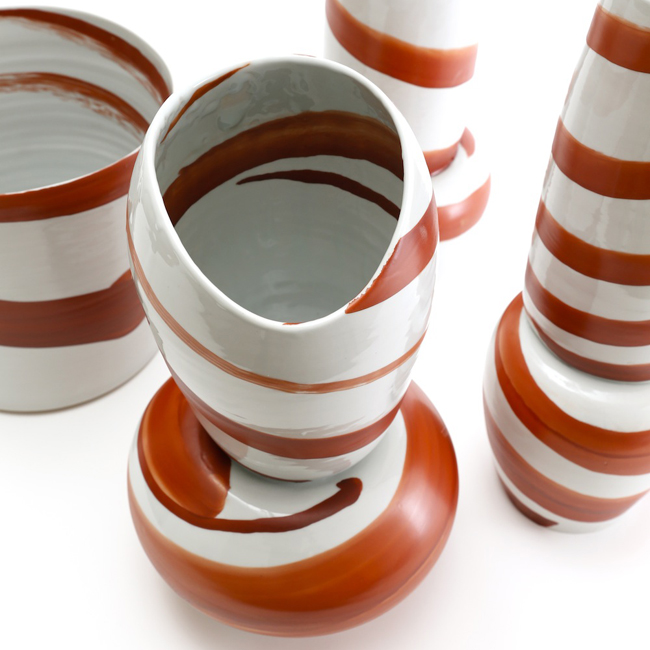Ken Akaji is a Japanese potter making porcelain vessels twisting with motion, vitality and youthfulness. Akaji is 77 years-old, but his vibrant pots are giving his native contemporaries half his age, like Takuro Kuwata and Hitomi Hosono, a run in defining the new face of contemporary Japanese pottery. His first exhibition held outside of Japan was on view at Ippodo Gallery (New York, June 18, 2015 – July 03, 2015) and it revealed a prolific artist with a fresh vision. His use of traditional Kutani color, red and green, is innovation and the bright white ground achieves a candy-like luminescence.
Above image: Ken Akaji, Vases with spiral brush pattern

Ippodo comments on Akaji’s determination not to be a follower:
Akaji is a part of the Kutani ceramics world, but it would appear that his philosophical designs have always been driven by his rebellious spirit. He has struggled against taking the easy way presented by tradition, banal Kutaniware, the arguably shallow aspects of contemporary art, and outdated ideas or concepts.”

Until he was 15 years old, he lived in the district of Kanazawa that was famous for it’s geishas. He would observe the bengara (red iron oxide) that was used to paint the lattices on the front of the buildings in the area’s side streets – streets that were filled with the comings and goings of adult men and women.”
He reminisces that this is the origin of the red he uses in his work. Additionally, he comes from a family of lacquer workers. His uncle was the ‘Living National Treasure,’ Yusai Akaji, and his father produced the wooden bases for lacquer artists. So when Akaji left home to start work in the ceramics world, he chose red for his works, as it was the same red (vermilion) his family had used for generations in their own work.”

Ken Akaji’s new work proves there is a way to talk about history in a language even millennials can be excited about. It’s like the feeling I get when my grandfather, who often sends me newspaper clippings, shoots me an email instead. This latest display of Akaji’s work should encourage young Japanese potters to be bolder, louder, and break from tired replicated traditions of Japanese ceramics.
Justin Crowe is a Writer and Director of Operations at cfile.daily
What do you think of Ken Akajis’ contemporary Japanese pottery? Let us know in the comments below!











Exciting – is is very difficult to buy a piece? love the age v the movement of the brush.
It’s beautiful, I love it! It is strong, bold, fluid, gestural, masterful, elegant, and timeless but very contemporary.